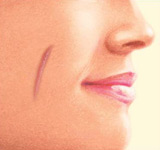Scarring is one of the primary concerns among patients considering plastic surgery at my Chicago practice. As a leader in the field of wound healing who’s conducted extensive research on the cause, prevention, and treatment of scars, I have decided to address the subject in a series of blog posts over the next few months.
So what causes a scar to develop? Scars result any time a wound occurs and the skin heals itself. Traumatic injuries and surgical incisions both lead to scarring. The difference is in the former circumstance, scar formation is unpredictable. On the other hand, careful surgical techniques minimize and disguise scars.
The healing process is similar for all skin, but scars do differ depending on the wound’s severity. When the skin is cut, the body immediately begins to heal by working to limit blood loss. New tissue gradually forms to cover the wound, and the body produces a protein called collagen to repair the skin.
There are 4 common types of scars:
- Immature hypertrophic scars: These red and slightly elevated young scars gradually return to normal over time.
- Hypertrophic scars: These red and raised scars are itchy and may be thickened and widened, but they don’t extend beyond the wound’s borders.
- Minor keloids: These raised and itchy scars extend across normal tissue, but they are limited to a specific area.
- Major, high-risk keloids: These painfully itchy and elevated scars extend beyond the wound’s borders and may continue growing over time, causing large scars even when the injury is small.
Hypertrophic scarring often occurs on areas of the body where the skin is particularly tight and may result when wounds get infected or reopen because collagen fibers are disrupted. It’s not clear exactly why keloid scars develop, but they are more common for people with darker skin. However, they may occur in people of any skin type.
Board-certified plastic surgeons are trained to prevent the development of hypertrophic scars or keloids after surgery by using precise techniques and taking steps to prevent postsurgical infection.
In my next blog post, I’ll discuss my approach to wound healing and the preventive techniques I use for patients, including innovative scar reduction techniques employed in tummy tuck surgery and other cosmetic procedures that require longer incisions.





Leave a Reply